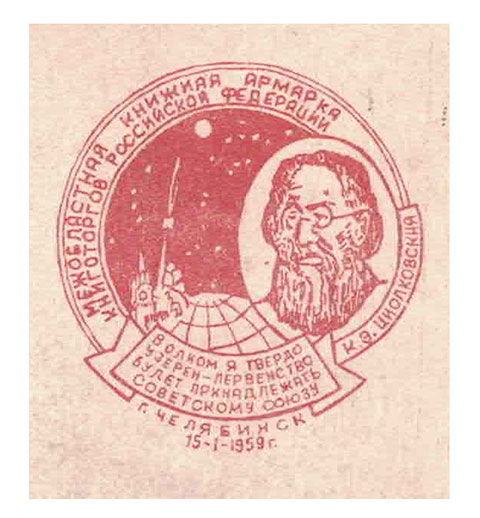Space Cover #536: Soyuz 1-11 Club Cachets, Part 1In Space Cover of the Week 533, Dennis Dillman wrote up the three launches of Soyuz 6, 7 and 8, which were all in space at the same time. In that article he alluded to my signed Tartu covers for those missions, stating that I might be able to add some info on those types of covers.
I have event covers signed by every astronaut and cosmonaut who entered space in the 1960s through the 1980s, with two exceptions: Vladimir Komarov (who died in the Soyuz 1 crash but whose signature I have on a cover for his Voskhod 1 flight); and Vladislav Volkov, who died in the Soyuz 11 disaster (but I do have him on a Moscow cover along with his crewmates). I don't have Greg Jarvis either, but then he never got into space.
Here are the covers that I have for the first 11 Soyuz missions. In response to Dennis' request to shed some light on the Tartu covers but to do that I have to introduce the Soviet "Club Cachets."
The first space-related Club Cachet (I believe) honored Constantine Tsiolkovsky, created by a stamp club in Chelyabinsk Russia (Челя́бинск), a city in Russia on January 15, 1959. The club created an unknown number of cacheted covers, with one for each of their club members.
That set the stage for the creation of Club Cachets for Sputnik 1. Fifty-four (54) different stamp clubs in Russia created Club Cachets in quantities ranging from just a few, to 1,210 which were created in four different colors by a club in the 1.6 million citizens city of Novosibirsk (Russian: Новосиби́рск).
The City of Tartu created the second most cachets at 1,000, with five different colors used. Tartu is located in present day Estonia.
By the launch of Vostok 1 there were a total of 140 different cachets produced across the Soviet Union over a five year period. Some clubs were sending their cachets to places like East Germany where other collectors fed them to Western Countries, such as France.
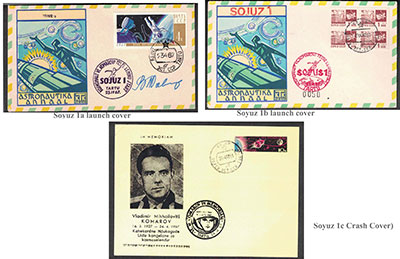
The Soviet government saw rampant capitalism taking place through these clubs and banned them from creating any more cacheted covers after the Voskhod 2 flight. As a result all of the clubs, except for the Tartu club, or most probably an individual who had been in that club, ceased creating covers (Karaganda and Magadan also).
Tartu created three different cachets for the Soyuz 1 flight. The first design (1a) is shown above of which 210 covers were created. There were 140 cacheted in black (pictured); 40 cacheted in orange, 35 created in red and 35 more in violet. (The signature is not that of Vladimir Korolov who died in the crash, but rather Soyz 25 cosmonaut Vladimir Kovalyonok of Soyuz 25). Fifty (50) more were created with a slightly different red cachet (1b). One of those 50 is also shown above.
When the Soyuz 1 craft crashed due to a parachute malfunction, a third cachet (1c) was created in black in a quantity of 250 (also shown above).
Note: All of my club cachet listings come from the H.R. Pfau catalog, SOWJETUNION II – Nebenstempel Vignetten Briefe, written in 1976.
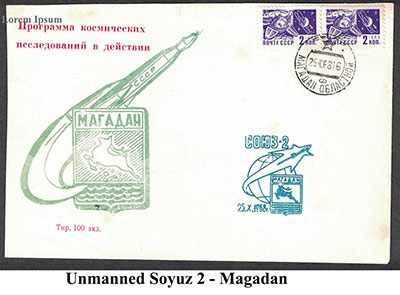
The Pfau catalog shows only one Tartu Cachet (250 in four different covers). He did not list the Magadan cover shown above. This was an unmanned flight.
Around this time, noted astrophilatelist Les Winick wrote to the Soviet Kniga Agency in Moscow inquiring about the Tartu covers. He received a letter back informing him that these covers were illegal. He assumed that they meant that they were fakes and he published a report reporting their illegality. But I continued looking for and buying Tartu covers because in many cases these were the only correctly dated covers from the Soviet Union that I could find. I sent for almost all of the cosmonaut autographs shown on the following covers, except for the Soyuz 11 flight for which no signed covers are known for launch.
Later, I came to realize that there was a different meaning to "illegal" in the Soviet Union. It did not mean that the cancels from Tartu were not authentic. It meant that no one was allowed to create space covers due to the capitalistic uses that the clubs had turned these into. The Tartu cancels were legitimate but it was against the law to create covers using them.
I also learned that the man who created the Tartu covers after the Soviet government forbade their creation was found guilty and was jailed for two years for his capitalistic practices.
Many other collectors who read Les's article quit collecting Tartu covers and that made it easier for me to find them.
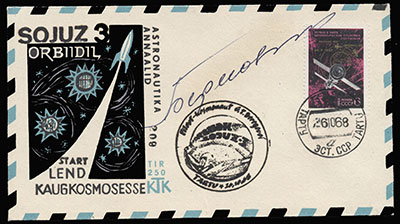
The Pfau catalog lists 250 covers in four colors (black, red, carmine and brown) for each the launch and the landing of this manned Soyuz 3 launch. This is a launch dated cancel from Tartu with a black cachet, of which 100 exist. It is signed by cosmonaut Beregovoy. Evidently the cosmonauts were not advised that these were "illegal."
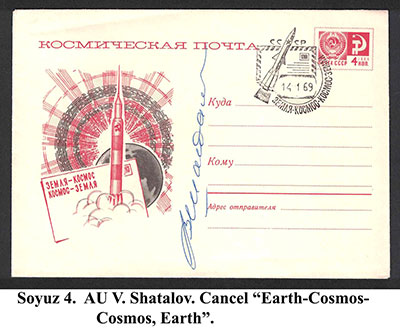
I don't have any of the three Tartu covers created for the Soyuz 4 mission. There were only 35 covers bearing the red Club Cachet for launch that looks like a blob, that could be a rocket with what appears to be lines showing orbital loops. The second Club Cachet for the launch pictures a cosmonaut in a double ring and waving; 250 of those exist. The third Club Cachet is for the landing on Jan. 17, 1969 and pictures three open parachutes. There were also 250 of these.
What I do have for Soyuz 4 is a neat cover with a cancel that has no city or country and is shown above. Both the printed black and red cachet and the cancel picture a space cover and a rocket. Around the dated postmark are the words "EARTH-COSMOS-KOSMOS-EARTH." The lone cosmonaut, V. Shatalov, was involved in an automatic docking with the Soyuz 5 spacecraft. This cover was signed through the mail by Shatalov. Printed text across the top of the cover reads "COSMONAUT MAIL."
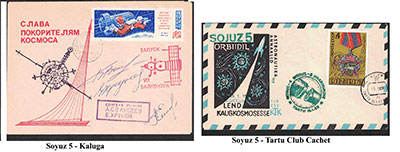
Reaching 50 years back in my memory I believe that either four or five of these covers were flown into space aboard Soyuz 5. There were three cosmonauts aboard. Again, only Tartu is listed in the Pfau catalog for cachets. My cover has a Karaganda cachet for the launch date and shows the Reaching for Space monument, found in Moscow, and a view of a Soyuz craft about to dock.
This mission carried a crew of three cosmonauts: Boris Volynov, Alexksei Yeliseev and Yevgeny Khronov, who have each signed this cover. Yeliseev and Khrunov transferred to Soyuz 4 in which they later landed with the original pilot of Soyuz 4, Vladimir Shatalov. They took the four or five covers into the Soyuz 4 craft with them. Those covers now reside in museums in the former Soviet Union. A large quantity of these covers were printed and given to employees at the launch site from what I can recall. I think it was 500 covers like the Soyuz 4 cover shown earlier.
I will continue with more information about the Soyuz 6 through 10 Tartu, Karaganda and Moscow covers from my collection. I am seeking Tartu covers for Soyuz 2, 4, 10 and 11, along with four Mars 1 Club Cachets, which I'll name in part two of this topic.











